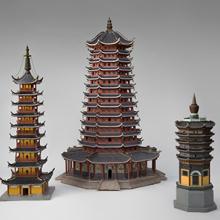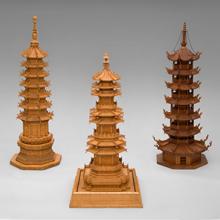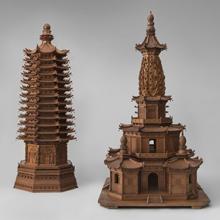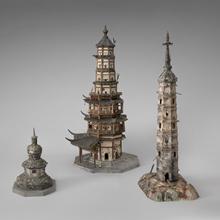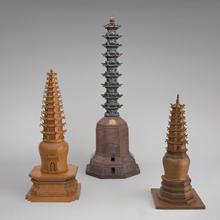International Terminal






Square Pagoda 1912–15
Songjiang, Shanghai
Northern Song Dynasty (1068–1077 CE)
Original Height: 159 ft / 48.5 m
Building Material: Brick and Wood
Courtesy of the Jeffries Family Private Collection
130441/Catalog No. 37 L2014.2601.081
Pagoda of the Six Harmonies 1912–15
Hangzhou, Zhejiang
Built 970 CE; Song Dynasty (960–1279 CE) / Rebuilt 1176 CE
Original Height: 276 ft / 84.1 m
Building Material: Brick and Wood
Courtesy of the Jeffries Family Private Collection
130448/Catalog No. 15
L2014.2601.068
Literary Peak Pagoda 1912–15
Anyang, Henan
Qing Dynasty, Qianlong Reign (1736–95 CE)
Original Height: 125 ft / 38.1 m
Courtesy of the Jeffries Family Private Collection
130398/Catalog No. 22
L2014.2601.022
 Pagoda of the Six Harmonies
Pagoda of the Six Harmonies
The Pagoda of the Six Harmonies was originally built in 970 for the ruler of the Wuyue Kingdom. Its primary purpose was calming the tidal waters of the Qiantang River, but it also served as a navigational lighthouse. It was destroyed during warfare in 1121 and was completely reconstructed in 1176. The pagoda is considered to be a masterpiece of ancient Chinese architecture. From its exterior, it appears to be a thirteen-story building, but it only contains seven interior stories. A spiral staircase leads to the top floor, with each of its seven ceilings elaborately decorated with carved and painted figures. Finely painted depictions of the Buddha decorate the exterior walls of the first floor on this model.
White Jade Pagoda 1912–15
Near Summer Palace, Beijing
Qing Dynasty, Kangxi Reign (1662–1723 CE)
Original Height: 75 ft / 22.8 m
Building Material: Marble
Courtesy of the Jeffries Family Private Collection
130382/Catalog No. 7
L2014.2601.009
Thousand Buddhas Pagoda or All Precious Pagoda 1912–15
Summer Palace, Beijing
Qing Dynasty (1644–1911 CE)
Original Height: 57 ft / 17.3 m
Building Material: Glazed Tiles
Courtesy of the Jeffries Family Private Collection
130381/Catalog No. 5
L2014.2601.008
Western Woods Pagoda 1912–15
Songjiang, Jiangsu
Ming Dynasty (1387 CE)
Original Height: 148 ft / 45.1 m
Building Material: Brick
Courtesy of the Jeffries Family Private Collection
130440/Catalog No. 38
L2014.2601.061
 One Thousand Buddhas
One Thousand Buddhas
This extraordinarily detailed model may indeed present the thousand Buddhas for which the pagoda is named. Each of the three largest stories of the octagonal structure features hand-carved Buddhas in central niches surrounded by hundreds of smaller Buddhas in respectively smaller niches. Every detail of this model exhibits a remarkable level of craftsmanship, including several ornate balustrades and intricately constructed roof elements that reveal its layered construction.
Precious Pagoda 1912–15
Pingliang, Gansu
1457 CE; Ming Dynasty (1368–1644 CE)
Original Height: 181 ft / 55.2 m
Building Material: Brick and Stone
Courtesy of the Jeffries Family Private Collection
130412/Catalog No. 69
L2014.2601.034
Pagoda 1912–15
Jinzhou, Liaoning
Liao Dynasty (907–1125 CE)
Building Material: Brick and Stucco
Courtesy of the Jeffries Family Private Collection
130388/Catalog No. 24
L2014.2601.013
Golden Island Pagoda of the Compassionate Longevity Temple 1912–15
Zhenjiang, Jiangsu
Ming Dynasty (1368–1644 CE)
Original Height: 145 ft / 44.2 m
Building Material: Brick and Wood
Courtesy of the Jeffries Family Private Collection
130436/Catalog No. 43
L2014.2601.058
Pagoda of Jinzhou
 This beautifully detailed model reflects the limitations of Brother Beck’s reliance on information from a variety of sources. Although it was catalogued as the 220-foot-tall Twin Pagoda from Jinzhou constructed in the Song Dynasty, this model depicts a smaller contemporary made in the architectural style of the Liao Dynasty. The surfaces of this octagonal structure are decorated with more than one hundred painted panels depicting vines, flowers, pastoral scenes, and a variety of creatures. The walls of the ground floor feature Daoist immortals and famous literati, including Wang Xizhi, the fourth-century calligrapher who was said to have observed the movements of geese to practice his calligraphy.
This beautifully detailed model reflects the limitations of Brother Beck’s reliance on information from a variety of sources. Although it was catalogued as the 220-foot-tall Twin Pagoda from Jinzhou constructed in the Song Dynasty, this model depicts a smaller contemporary made in the architectural style of the Liao Dynasty. The surfaces of this octagonal structure are decorated with more than one hundred painted panels depicting vines, flowers, pastoral scenes, and a variety of creatures. The walls of the ground floor feature Daoist immortals and famous literati, including Wang Xizhi, the fourth-century calligrapher who was said to have observed the movements of geese to practice his calligraphy.
Pagoda from the Temple of Heavenly Tranquility 1912–15
Wanping, Hebei (present-day Beijing)
Ming Dynasty (1368–1644 CE)
Original Height: 279 ft / 85 m
Building Material: Brick and Stucco
Courtesy of the Jeffries Family Private Collection
130383/Catalog No. 9
L2014.2601.010
Flower Pagoda 1912–15
Zhengding, Hebei
Tang Dynasty (618–907 CE)
Original Height: 150 ft / 47.7 m
Building Material: Brick and Stucco
Courtesy of the Jeffries Family Private Collection
130389
L2014.2601.014
 Zhenging’s Flower Pagoda
Zhenging’s Flower Pagoda
The structure of Zhengding’s Flower Pagoda, with a central tower surrounded by four lower structures, is unique among the Tushanwan pagodas. Its shape may have two origins. Although a similar architectural style was employed in the construction of Chinese granary houses in the fourth century, the building’s inspiration more likely derived from the sixth-century Mahabodhi temple in Bihar, India, where the Buddha is said to have obtained his enlightenment. The model’s tower appears to map a Buddhist cosmos and hierarchy, with a series of lion and human figures that closely resemble those found on furniture made at Tushanwan.
Chorten (Tibetan stupa) 1912–15
Sichuan
Date unknown
Original Height: 32 ft / 9.8 m
Building Material: Brick
Courtesy of the Jeffries Family Private Collection
130372
L2014.2601.001
Scaling the Clouds Pagoda 1912–15
Nankang, Jiangxi
Song Dynasty (1097 CE)
Original Height: 124 ft / 37.8 m
Building Material: Stone, Brick, and Wood
Courtesy of the Jeffries Family Private Collection
130429/Catalog No. 32
L2014.2601.051
Pagoda at She Hill 1912–15
Songjiang, Shanghai
Northern Song Dynasty (976–984 CE)
Original Height: 96 ft / 29.3 m
Building Material: Brick
Courtesy of the Jeffries Family Private Collection
130443/Catalog No. 42
L2014.2601.063
 Pagodas in Ruin
Pagodas in Ruin
The model makers at Tushanwan depicted many of their subjects in their relative states of ruin in the early twentieth century. The proximity of pagodas to Catholic missions in Shanghai and Jiangxi allowed for a close and careful study of a structure’s details, which were faithfully presented with missing tiles, damaged bricks, and overgrown vegetation. In creating the models for Scaling the Clouds pagoda and Pagoda at She Hill, model makers replicated the broken and missing roof structures by inserting and then breaking wooden elements, and included figurines of humans for scale.
Temple of White Robe Pagoda 1912–15
Lanzhou, Gansu
1631 CE; Ming Dynasty (1368–1644 CE)
Original Height: 78 ft / 23.7 m
Building Material: Brick and Stucco
Courtesy of the Jeffries Family Private Collection
130374/Catalog No. 68
L2014.2601.002
Iron Pagoda of Esteemed Wakening Temple 1912–15
Yanzhou, Shandong
1105 CE; Northern Song Dynasty (960–1127 CE)
Original Height: 100 ft / 30.4 m
Building Material: Brick base, Iron tower
Courtesy of the Jeffries Family Private Collection
130396/Catalog No. 58
L2014.2601.020
The Temple of Compassionate Kindness Pagoda 1912–15
Lanzhou, Gansu
1592 CE; Ming Dynasty (1368–1644 CE)
Original Height: 75 ft / 22.9 m
Building Material: Brick and Stucco
Courtesy of the Jeffries Family Private Collection
130375/Catalog No. 83
L2014.2601.003
 In the Style of a Stupa
In the Style of a Stupa
Pagodas at the Temple of White Robe and the Temple of Compassionate Kindness were built in a style similar to Tibetan and Nepalese stupas, with bell-shaped bodies on stepped bases. The cone-shaped tower of the Temple of White Robe Pagoda has twelve stories, an unusual number, as most pagodas have an odd number of stories. The body houses a shrine containing three sculptures, and on each side of the twelve stories is a shrine for a Buddhist sculpture.
